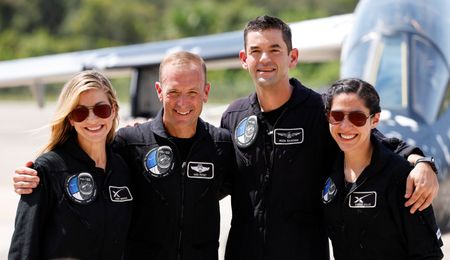By Joey Roulette
WASHINGTON (Reuters) -The first private spacewalk is set for Thursday by a group of astronauts who will leave a SpaceX capsule after a delay of a few hours, testing a new line of spacesuits in the company’s riskiest mission yet.
A billionaire entrepreneur, a retired military fighter pilot and two SpaceX employees have been orbiting Earth aboard Crew Dragon since Tuesday’s pre-dawn launch from Florida of the Polaris Dawn mission.
It is the Elon Musk-led company’s latest and riskiest bid to push the boundaries of commercial spaceflight.
Live streaming of the event is set to begin at 4:55 a.m. ET (0855 GMT), SpaceX said on Thursday, with two astronauts venturing outside Crew Dragon while two stay inside.
The capsule, at an altitude of 700 km (435 miles), will be completely depressurized, and the whole crew will rely on their slim, SpaceX-developed spacesuits for oxygen.
Jared Isaacman, 41, a pilot and the billionaire founder of electronic payments company Shift4, is bankrolling the Polaris mission, as he did his Inspiration4 flight with SpaceX in 2021.
He has declined to say how much he is paying for the missions, but they are likely to cost hundreds of millions of dollars, based on Crew Dragon’s price of roughly $55 million a seat for other flights.
The others in Polaris include mission pilot Scott Poteet, 50, a retired U.S. Air Force lieutenant colonel, and SpaceX employees Sarah Gillis, 30, and Anna Menon, 38, both senior engineers.
FARTHEST SINCE APOLLO
Throughout Wednesday the spacecraft circled Earth at least six times in an oval-shaped orbit as shallow as 190 km (118 miles) and stretching out as far as 1,400 km (870 miles), the farthest in space humans have traveled since the last U.S. Apollo mission in 1972.
The gumdrop-shaped spacecraft then began to lower its orbit into a peak 700-km (435-mile) position and adjust cabin pressure to ready for the spacewalk, formally called Extravehicular Activity (EVA), the Polaris program said on social media on Wednesday.
“The crew also spent a few hours demonstrating the suit’s pressurized mobility, verifying positions and accessibility in microgravity along with preparing the cabin for the EVA,” it said.
During the spacewalk, Isaacman and Gillis will exit the Crew Dragon tethered by an oxygen line while Poteet and Menon stay within.
Only government astronauts with several years of training have done spacewalks in the past.
There have been roughly 270 on the International Space Station (ISS) since it was set up in 2000, and 16 by Chinese astronauts on Beijing’s Tiangong space station.
The Polaris crew has spent 2-1/2 years of training with SpaceX mission simulations and “experiential learning” in challenging, uncomfortable environments, said Poteet.
Last month the fighter pilot told reporters in Florida that spaceflight preparation was more intense than he had experienced in his military career.
“I can tell you without a doubt this has been some of the most challenging training that I’ve ever experienced,” Poteet said in Cape Canaveral before the launch.
The spacewalk will happen as a record 19 astronauts orbit Earth, after Russia’s Soyuz MS-26 mission ferried two cosmonauts and a U.S. astronaut to the International Space Station on Wednesday, taking its headcount to a rare high of 12.
Three Chinese astronauts are aboard the Tiangong space station.
The first U.S. spacewalk in 1965, aboard a Gemini capsule, used a similar procedure to the one planned for Polaris Dawn: the capsule was depressurized, the hatch opened, and a spacesuited astronaut ventured outside on a tether.
During the mission, the private Polaris astronauts will be subjects for a range of scientific studies on how the human body reacts to deep space, adding to decades of health studies on government astronauts on the ISS.
Since 2001, Crew Dragon, the only U.S. vehicle capable of reliably putting humans in orbit and returning them to Earth, has flown more than a dozen astronaut missions, mainly for NASA.
The agency seeded development of the capsule under a program meant to establish commercial, privately-built U.S. vehicles capable of ferrying astronauts with the ISS.
Also developed under that program was Boeing’s Starliner capsule, but it is farther behind.
Starliner launched its first astronauts to the ISS in June in a troubled test mission that ended this month with the capsule returning empty, leaving its crew on the space station for a Crew Dragon capsule to fetch next year.
(Reporting by Joey Roulette and Gerry Doyle; Editing by Jamie Freed and Clarence Fernandez)











